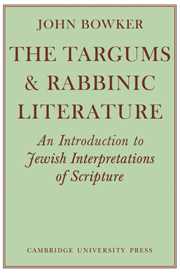Book contents
- Frontmatter
- Contents
- Preface
- Acknowledgements
- Note on the 1979 reprint
- Note on transliteration
- Note on bibliographical references
- List of abbreviations
- INTRODUCTION: THE BACKGROUND OF THE TARGUMS
- 1 Translation and Interpretation
- 2 Pre-Rabbinic Literature
- 3 Non-Rabbinic Literature
- 4 Classical Rabbinic Literature
- PS. JONATHAN ON SELECTED CHAPTERS OF GENESIS
- Appendices
- Bibliography
- Indexes
4 - Classical Rabbinic Literature
Published online by Cambridge University Press: 01 June 2011
- Frontmatter
- Contents
- Preface
- Acknowledgements
- Note on the 1979 reprint
- Note on transliteration
- Note on bibliographical references
- List of abbreviations
- INTRODUCTION: THE BACKGROUND OF THE TARGUMS
- 1 Translation and Interpretation
- 2 Pre-Rabbinic Literature
- 3 Non-Rabbinic Literature
- 4 Classical Rabbinic Literature
- PS. JONATHAN ON SELECTED CHAPTERS OF GENESIS
- Appendices
- Bibliography
- Indexes
Summary
Halakah and Haggadah, Midrash and Mishnah
These basic words can be very broadly defined as follows: halakah and haggadah describe the content of rabbinic literature, midrash and mishnah describe the method and form of that literature. Putting it as simply as possible, halakah is regulative material (showing how written Torah should be applied in life), haggadah is illustrative material (illustrating what scripture means); midrash describes the way in which both sorts of material were collected together by being attached to the text of scripture, mishnah describes the way in which the material was collected together in its own right, without necessarily being attached to a text of scripture. Those general definitions can now be explained in greater detail.
It has been pointed out already that the foundations of Judaism were laid in Torah and in scripture in general. The vitality of Judaism has always depended on the effectiveness with which Torah can be made relevant, applicable and inspiring to any generation of people at a later time. The Pharisees emerged in the second century b.c. as a group (or better, ‘groups’, since there was no internal unanimity) determined to work out the full implications of Torah for every succeeding generation, and to maintain the total relevance of Torah to life. To them this meant unceasing study of Torah, searching constantly for its interpretation, particularly when it seemed to have lost its relevance in ever-changing situations.
- Type
- Chapter
- Information
- The Targums and Rabbinic LiteratureAn Introduction to Jewish Interpretations of Scripture, pp. 40 - 92Publisher: Cambridge University PressPrint publication year: 1969



